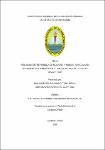| dc.contributor.advisor | Sologuren Anchante, Rafael Fernando | |
| dc.contributor.author | Pasmiño Shahuano, Tony Ronal | |
| dc.contributor.author | Saavedra Rengifo, Claytong | |
| dc.date.accessioned | 2019-03-07T18:17:30Z | |
| dc.date.available | 2019-03-07T18:17:30Z | |
| dc.date.issued | 2019 | |
| dc.identifier.uri | http://repositorio.unapiquitos.edu.pe/handle/20.500.12737/5930 | |
| dc.description.abstract | El propósito del presente estudio fue establecer relación entre la pérdida de molares y ruidos articulares en pacientes atendidos en el Puesto de Salud 1-2 Santo Tomás, en el año 2018. El tipo de investigación fue cuantitativa, el diseño fue no experimental, correlacional, transversal. La muestra estuvo conformada por 290 pacientes adultos que acudieron al Puesto de Salud 1-2 Santo Tomás, en el año 2018. El instrumento utilizado en el presente estudio fue una ficha de recolección de datos para pérdida de dientes molares que incluyó la ficha de consentimiento informado. Los resultados más importantes fueron: El 39,3% de pacientes perdió de 3 a 4 dientes. El 30,7% de pacientes perdió dientes en 2 cuadrantes. La media de edad de la muestra fue 44,50. En la ATM derecha, durante movimientos de apertura y cierre, existe relación entre click, crepitación, y dientes faltantes, detectada por el paciente y el examinador; existe relación entre dolor clínico, dolor familiar y dientes faltantes. En la ATM izquierda, durante movimientos de apertura y cierre, existe relación entre click, crepitación, y dientes faltantes, detectada por el paciente y el examinador; existe relación entre dolor clínico y dientes faltantes; no existe relación entre dolor familiar y dientes faltantes. En la ATM derecha, durante movimientos de lateralidad y protrusión, existe relación entre click, crepitación, y dientes faltantes, detectada por el paciente y el examinador; existe relación entre dolor clínico y dientes faltantes; no existe relación entre dolor familiar y dientes faltantes. En la ATM izquierda, durante movimientos de lateralidad y protrusión, existe relación entre click, crepitación, y dientes faltantes, detectada por el examinador; existe relación entre click y dientes faltantes detectado por el paciente; no existe relación entre crepitación y dientes faltantes, detectada por el paciente; existe relación entre dolor clínico y dientes faltantes; no existe relación entre dolor familiar y dientes faltantes. Existe relación entre dientes faltantes y ruido articular. Existe relación entre ruido articular y cuadrantes con dientes faltantes. | es_PE |
| dc.description.abstract | The purpose of the present study was to establish a relationship between the loss of molars and joint sounds in patients seen at the Santo Tomás Health Post 1-2 in 2018. The type of research was quantitative, the design was non-experimental, correlational, cross. The sample consisted of 290 adult patients who attended the Health Post 1-2 St. Thomas, in 2018. The instrument used in the present study was a data collection card for loss of molar teeth that included the consent form informed. The most important results were: 39.3% of patients lost 3 to 4 teeth. 30.7% of patients lost teeth in 2 quadrants. The mean age of the sample was 44.50. In the right ATM, during opening and closing movements, there is a relationship between click, crepitus, and missing teeth, detected by the patient and the examiner; There is a relationship between clinical pain, family pain and missing teeth. In the left ATM, during opening and closing movements, there is a relationship between click, crepitus, and missing teeth, detected by the patient and the examiner; there is a relationship between clinical pain and missing teeth; there is no relationship between family pain and missing teeth. In the right ATM, during movements of laterality and protrusion, there is a relationship between click, crepitus, and missing teeth, detected by the patient and the examiner; there is a relationship between clinical pain and missing teeth; there is no relationship between family pain and missing teeth. In the left ATM, during movements of laterality and protrusion, there is a relationship between click, crepitus, and missing teeth, detected by the examiner; there is a relationship between click and missing teeth detected by the patient; there is no relationship between crepitus and missing teeth, detected by the patient; there is a relationship between clinical pain and missing teeth; there is no relationship between family pain and missing teeth. There is a relationship between missing teeth and joint noise. There is a relationship between joint noise and quadrants with missing teeth. | en_US |
| dc.description.uri | Tesis | es_PE |
| dc.format | application/pdf | es_PE |
| dc.language.iso | spa | es_PE |
| dc.publisher | Universidad Nacional de la Amazonía Peruana | es_PE |
| dc.rights | info:eu-repo/semantics/openAccess | es_PE |
| dc.rights | Attribution 3.0 United States | * |
| dc.rights.uri | http://creativecommons.org/licenses/by/3.0/us/ | * |
| dc.source | Universidad Nacional de la Amazonía Peruana | es_PE |
| dc.source | Repositorio institucional - UNAP | es_PE |
| dc.subject | Perdida de diente | es_PE |
| dc.subject | Dientes molares | es_PE |
| dc.title | Relación entre pérdida de molares y ruidos articulares en pacientes atendidos en el Puesto de Salud 1-2 “Santo Tomás”, 2018 | es_PE |
| dc.type | info:eu-repo/semantics/bachelorThesis | es_PE |
| thesis.degree.discipline | Odontología | es_PE |
| thesis.degree.grantor | Universidad Nacional de la Amazonía Peruana. Facultad de Odontología | es_PE |
| thesis.degree.level | Título Profesional | es_PE |
| thesis.degree.name | Cirujano Dentista | es_PE |
| thesis.degree.program | Regular | es_PE |
| dc.subject.ocde | http://purl.org/pe-repo/ocde/ford#3.02.14 | es_PE |


